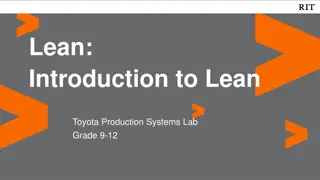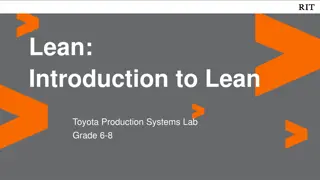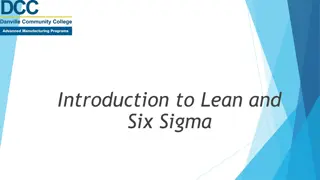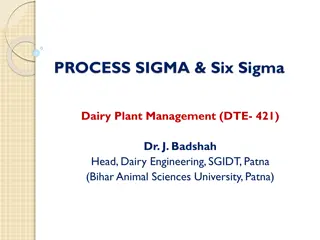Core Principles and Tools of Lean Six Sigma Green Belt
Combining the quality improvement strategies of Six Sigma with the lean waste reduction principles, Lean Six Sigma Green Belt is a potent methodology.
Uploaded on Aug 09, 2024 | 3 Views
Download Presentation

Please find below an Image/Link to download the presentation.
The content on the website is provided AS IS for your information and personal use only. It may not be sold, licensed, or shared on other websites without obtaining consent from the author.If you encounter any issues during the download, it is possible that the publisher has removed the file from their server.
You are allowed to download the files provided on this website for personal or commercial use, subject to the condition that they are used lawfully. All files are the property of their respective owners.
The content on the website is provided AS IS for your information and personal use only. It may not be sold, licensed, or shared on other websites without obtaining consent from the author.
E N D
Presentation Transcript
Core Principles and Tools of Lean Six Sigma Green Belt
Introduction: Combining the quality improvement strategies of Six Sigma with the lean waste reduction principles, Lean Six Sigma Green Belt is a potent methodology. Professionals holding a Lean Six Sigma Green Belt certification can make major contributions to their organizations by emphasizing improving efficiency and decreasing faults. We will examine the fundamental ideas and practical resources covered in a Six Sigma Green Belt course in this blog, emphasizing the ways in which lean six sigma green belt training can enable people to flourish in their positions.
Core Principles of Lean Six Sigma Green Belt 1. Focus on Customer Value: Maximizing customer value is the main objective of Lean Six Sigma. This entails being aware of the demands and expectations of the client and making sure that all procedures are set up to efficiently fulfill these needs. 2. Identify and Eliminate Waste: The elimination of waste in all its manifestations is emphasized by lean concepts. This entails cutting back on surplus inventory, cutting down on wait times, and getting rid of steps that aren't necessary in a process. The goal is to optimize efficiency by creating a streamlined procedure. 3. Reduce Variation and Defects: Six Sigma emphasizes defect elimination and process variation reduction as ways to raise quality. Professionals are able to determine the underlying causes of errors and carry out corrective measures through the application of statistical methods and tools. 4. Continuous Improvement: Lean Six Sigma promotes a continual improvement mindset. To accomplish continuous improvement, this entails evaluating procedures on a frequent basis, figuring out where they may be improved, and making small adjustments along the way. 5. Data-Driven Decision Making: Statistical analysis and statistics are used in Lean Six Sigma decision-making instead of gut feeling. This guarantees that the modifications are supported by data and have a better chance of succeeding. 6. Empowerment of Employees: Lean Six Sigma incorporates all staff members into the process of improvement. Organizations may harness various viewpoints and cultivate a feeling of ownership and accountability by involving team members at all levels.
Essential Tools Covered in Lean Six Sigma Green Belt Training DMAIC Framework: Six Sigma approach is based on the DMAIC (Define, Measure, Analyze, Improve, Control) framework. It offers a methodical approach to process improvement and problem solutions. Every stage of the DMAIC process, from problem definition to process control to guarantee long-term outcomes, focuses on a particular facet of the improvement process. Value Stream Mapping: A visual technique called value stream mapping (VSM) is used to examine how information and materials move through a process. Professionals can create more effective future-state processes by using it to assist identify waste and places for improvement. 5S Methodology:Organization and uniformity in the workplace are the main goals of the 5S methodology. Sort, Set in Order, Shine, Standardize, and Sustain are the five steps. Putting 5S into practice can increase efficiency, production, and safety. Root Cause Analysis (RCA): RCA is a method of problem-solving that's utilized to find the root causes of problems. Professionals can prevent issues from happening again and produce greater long-lasting improvements by addressing the underlying reasons. Pareto Analysis: A statistical method called Pareto Analysis can be used to determine which components are most important in creating an issue. It is predicated on the Pareto Principle, which says that about 20% of the causes account for 80% of the issues. Control Charts: Control charts are employed to track the performance of processes across time. They assist in spotting patterns, variances, and possible problems so that experts may take corrective action before mistakes happen. Kaizen:Kaizen, which translates to "continuous improvement" from Japanese, is a theory that supports gradual, tiny adjustments to procedures. It involves every employee in determining problem areas and putting fixes in place.
Benefits of Certification Six Sigma 1. Enhanced Problem-Solving Skills: Professionals undergoing Six Sigma Green Belt training are given the instruments and methods required to successfully address challenging issues. Defects decrease and process efficiency increases as a result. 2. Increased Employability: Employers in a variety of industries highly value Six Sigma certification. Because it shows a dedication to excellence and ongoing development, companies find certified professionals more appealing. 3. Higher Earning Potential: Professionals who hold a Six Sigma Green Belt certification are frequently paid more because of their specific knowledge and capacity to lead large-scale organizational improvements. 4. Improved Career Advancement Opportunities: Six Sigma Green Belt course can lead to opportunities in process improvement and quality management leadership. Because of their proficiency in promoting organizational excellence, certified experts are frequently in high demand. 5. Contribution to Organizational Success: Professionals with certifications in Lean Six Sigma can help their company succeed by cutting expenses, raising standards, and improving customer happiness through the use of these principles.
Conclusion: Professionals looking to boost their problem-solving abilities, increase process efficiency, and progress their careers will find that investing in Lean Six Sigma Green Belt training is a worthwhile endeavor. Individuals may significantly enhance their businesses by concentrating on fundamental concepts like customer value, waste reduction, and continuous improvement, and by becoming proficient with crucial techniques like DMAIC, Value Stream Mapping, and Root Cause Analysis. A Six Sigma Green Belt course is an essential step towards accomplishing your goals, whether they want to improve your employability, raise your earning potential, or help your organization succeed.
Slide End and Resource: Resource: https://www.mindcypress.com/blogs/quality- management/core-principles-and-tools-of-lean-six-sigma- green-belt Email: support@mindcypress.com Phone: +971 50 142 7401 +1-206-922-2417























